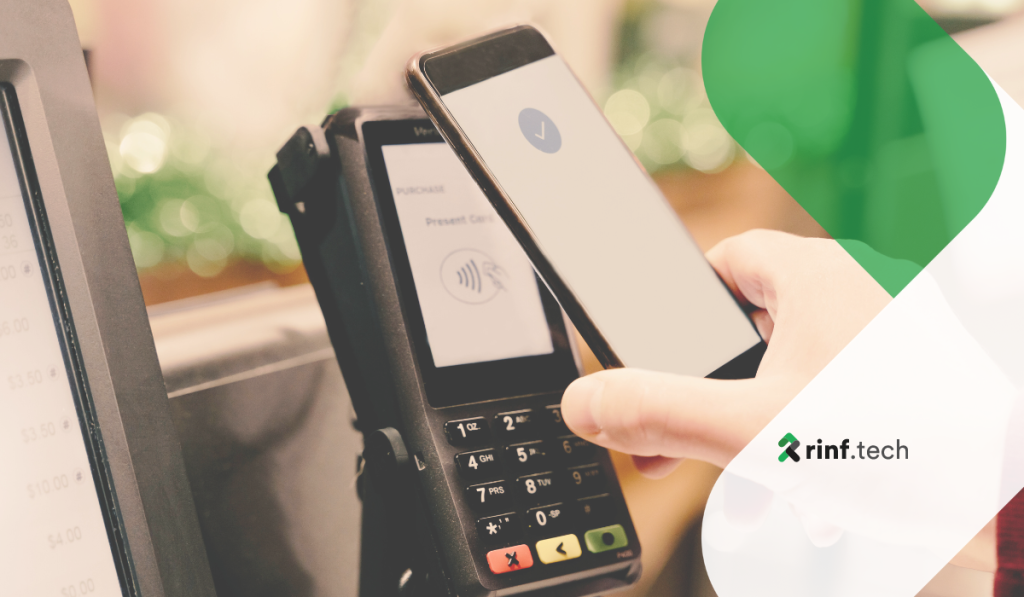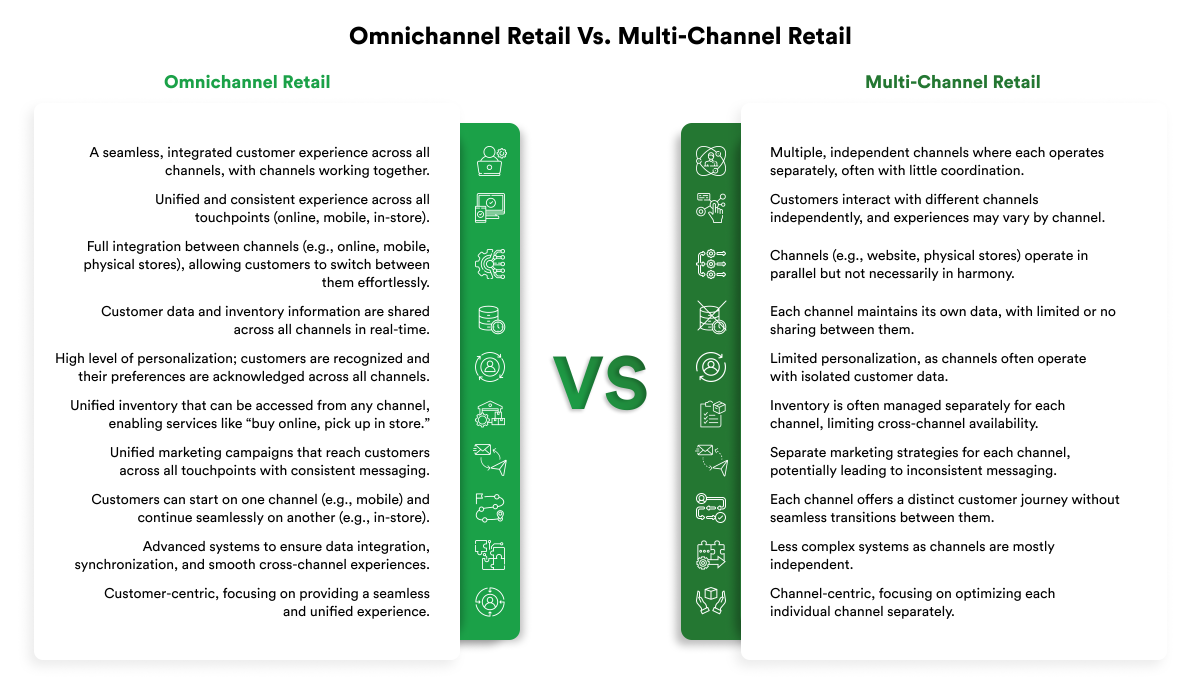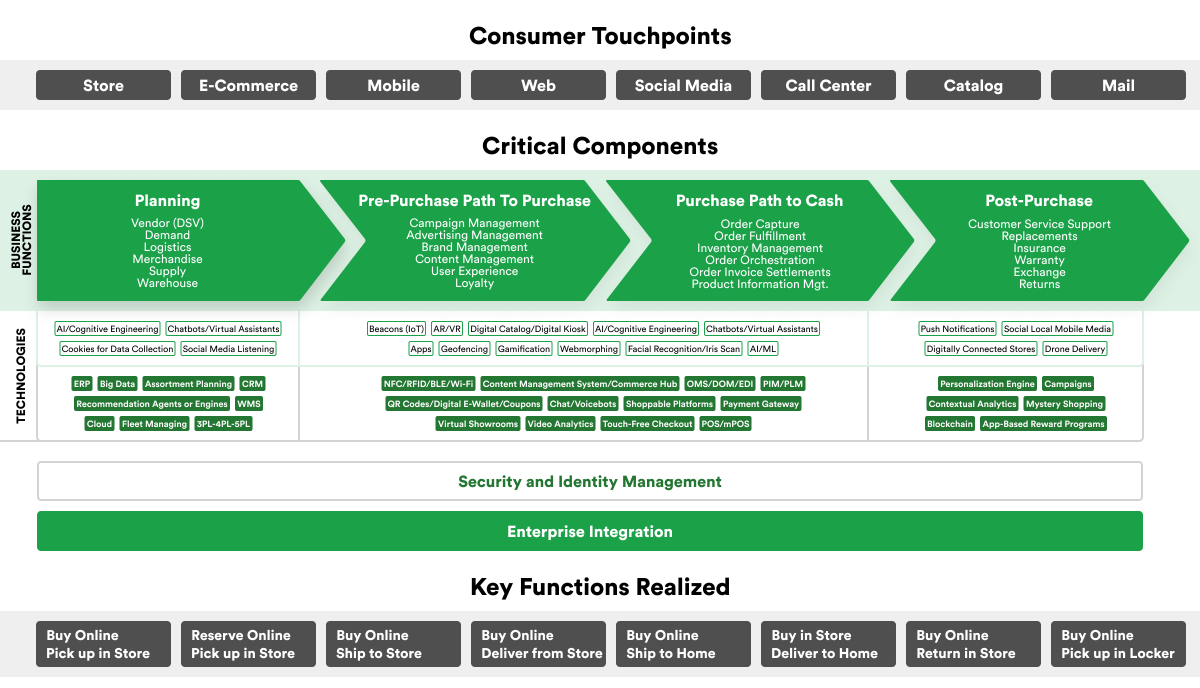
How Retail Embraces the Latest Fintech Innovations
A comprehensive overview of how fintech innovations drive significant changes in the retail industry.
Omnichannel retail refers to integrating all sales and marketing channels into a cohesive customer experience. Unlike multichannel retail, where different platforms operate independently, omnichannel retail ensures a seamless transition across every channel. Customers can switch from browsing a website to shopping in a physical store or engaging with a brand via social media, all while receiving consistent service and messaging.
Globally, the adoption of omnichannel strategies has seen a significant upward trajectory. According to recent statistics, approximately 73% of consumers now use multiple channels during their shopping journey. This shift reflects a fundamental change in consumer behavior, driven by the desire for convenience, flexibility, and personalized experiences.
This article aims to guide you through the essentials of omnichannel retail, showcasing its transformative benefits, the cutting-edge technologies fueling its growth, the challenges businesses face in its implementation, and the future trends that will define its evolution.
One of the biggest advantages of omnichannel retail is the ability to offer an exceptional customer experience. Through omnichannel strategies, retailers can leverage data to provide personalized recommendations, ensuring customers find products that meet their preferences quickly and easily. In addition, consistent branding and messaging across channels enhance the overall shopping journey.
Omnichannel strategies significantly reduce friction in shopping, fostering greater customer loyalty. By making it easy for customers to interact with a brand at any time and place, retailers are better positioned to meet consumer needs. The consistency offered through omnichannel retail strategies ultimately leads to improved customer satisfaction, which drives long-term loyalty and repeat purchases.
Beyond customer-facing benefits, omnichannel retail can also streamline back-end operations. For instance, we at rinf.tech have developed a global content portal for the healthcare supply chain that integrated multiple channels to ensure seamless information flow and real-time updates. This solution improved supply chain visibility, enabling faster response times and more accurate inventory management across the client’s network. The integration of omnichannel systems allowed the company to meet the increasing demand for medical supplies while maintaining operational efficiency and optimizing distribution strategies.
Retailers that adopt omnichannel strategies differentiate themselves from competitors by offering a more cohesive and integrated customer experience. This not only helps to attract new customers but also allows businesses to increase their market share and build a stronger brand reputation.

Omnichannel retail relies on cutting-edge technologies to deliver seamless, personalized customer experiences across multiple channels. These technologies improve the customer journey and optimize operations, driving efficiency and innovation in the retail industry.
AI and ML are at the heart of personalized shopping experiences in omnichannel retail. These technologies enable retailers to analyze vast amounts of customer data in real time, offering personalized recommendations, dynamic pricing, and targeted marketing. AI-driven chatbots and virtual assistants, for example, provide instant customer support, addressing queries and even helping with purchase decisions.
Additionally, AI enhances inventory management by predicting demand patterns, ensuring that products are available at the right time and location, and reducing stockouts and overstocking.
AR and VR technologies are transforming the way customers interact with products online, particularly in sectors like fashion, beauty, and home decor. AR allows customers to visualize products in their own environment before purchasing, while VR creates immersive shopping experiences. These technologies bridge the gap between online and offline shopping by offering a “try-before-you-buy” experience, which can increase conversion rates and reduce returns.
IoT plays a crucial role in omnichannel retail by connecting physical and digital touchpoints, enabling real-time data collection and analysis. IoT devices like smart shelves and RFID tags provide real-time inventory management, allowing retailers to track product availability across multiple locations. This real-time visibility is key to preventing stockouts and ensuring customers can easily find the products they need, whether online or in-store.
Blockchain is emerging as a transformative technology for supply chain transparency and security in omnichannel retail. By providing a strong and decentralized ledger, blockchain allows retailers to track products throughout the supply chain, from raw materials to the end consumer. This ensures greater transparency, reduces fraud and counterfeiting, and enables consumers to verify the authenticity and ethical sourcing of products.
The rise of voice-activated devices like Amazon Alexa, Google Assistant, and Apple’s Siri has given birth to voice commerce, allowing consumers to make purchases or search for products using voice commands. As this trend grows, retailers are incorporating voice commerce into their omnichannel strategies to offer customers another convenient way to interact with their brand.
Cloud technology supports omnichannel operations by enabling retailers to manage their systems, data, and customer interactions from a centralized platform. Cloud-based platforms facilitate real-time data synchronization across online and offline channels, ensuring customers receive consistent service and up-to-date information, such as inventory levels or order status.
Data analytics is the backbone of omnichannel retail strategies. According to a report by Deloitte, 62% of leading retailers are using analytics to gain a competitive advantage. Retailers collect vast amounts of data from various touchpoints—such as customer interactions, purchase history, and online behavior—and use advanced analytics to gain insights into customer preferences, market trends, and operational performance. This data is instrumental in creating personalized shopping experiences, optimizing product assortments, and improving marketing efforts.

While omnichannel retail offers significant advantages in customer experience and operational efficiency, implementing this approach presents a range of challenges.
One of the most significant barriers to implementing an omnichannel strategy is the technical complexity of integrating multiple systems and platforms. Retailers need to ensure that their e-commerce, point-of-sale (POS), customer relationship management (CRM), and inventory systems are all interconnected and able to communicate in real time. A Forrester study reveals that 45% of retailers cite the complexity of integrating disparate systems as one of the biggest challenges in executing an omnichannel strategy. Achieving this seamless integration often requires substantial IT investment and expertise, as outdated or incompatible systems can create roadblocks.
Many retailers, particularly those with long-established brick-and-mortar operations, rely on legacy systems not designed to support modern omnichannel technologies. 78% of retailers report that their legacy systems are holding back their omnichannel initiatives. These systems may be outdated, inflexible, and unable to communicate with newer technologies like AI, IoT, or data analytics platforms. Upgrading or replacing these systems requires a significant financial commitment, and the process can be time-consuming and disruptive to day-to-day operations.
Successfully implementing an omnichannel strategy often requires a shift in organizational culture and structure. Traditionally, retailers have operated in silos, with separate teams handling e-commerce, physical stores, and marketing. Omnichannel strategies, however, require cross-functional collaboration, where different departments work together to ensure a unified customer experience across all channels.
Transitioning to an omnichannel retail model requires substantial financial investment in technology, infrastructure, and human resources. Retailers must upgrade their IT systems, invest in real-time inventory management software, implement AI-driven personalization tools, and hire talent capable of managing these new technologies. According to Gartner, 24% of retail CIOs state that budget constraints are a significant obstacle to implementing digital transformation projects, such as omnichannel integration. For many smaller retailers, the upfront costs can be overwhelming, making it challenging to compete with larger retailers who have already made significant investments in omnichannel.
As retailers collect vast amounts of customer data through various channels, ensuring the security and privacy of that data becomes a critical challenge. Data breaches or misuse of personal information can severely damage a retailer’s reputation and result in legal consequences, especially with strict regulations like the General Data Protection Regulation (GDPR) in the European Union and the California Consumer Privacy Act (CCPA) in the United States.
Implementing and managing an omnichannel retail strategy requires specialized skills in data analytics, digital marketing, and IT systems integration. According to Statista, 54% of organizations still face a skills shortage, specifically in technology roles, which indicatesa persistent challenge in recruiting qualified personnel. Additionally, employees across all levels of the organization need to be trained to work within an omnichannel framework, which can be costly and time-consuming.
This shortage is a significant barrier for retailers looking to implement or scale their omnichannel operations.
One of the biggest challenges in omnichannel retail is keeping up with changing consumer behavior and expectations. Today’s consumers are accustomed to instant gratification, expecting fast delivery, easy returns, and a personalized experience across every touchpoint. According to a PwC report, 59% of global consumers value personalized experiences when shopping with a retailer. Retailers must be agile enough to adapt to these changing expectations, which may vary across customer segments and geographic markets.
The future of omnichannel retail is driven by rapid technological advancements and evolving consumer expectations. The next few years will witness a more interconnected retail environment, where the lines between online and offline shopping will blur even further.
Personalization will remain a dominant trend in the future of omnichannel retail. Advances in AI and ML will enable retailers to deliver hyper-personalized experiences at every stage of the customer journey. 71% of consumers expect companies to provide personalized interactions, and 76% get frustrated when this doesn’t happen. Retailers will use AI to analyze large datasets in real time, allowing them to predict customer preferences, recommend products, and customize promotions based on individual behaviors and interests.
The disparity between online and offline shopping will continue to fade as retailers focus on creating fully integrated omnichannel experiences. 91% of consumers are more likely to shop with brands that recognize, remember, and provide relevant offers and recommendations across all channels. Consumers will move effortlessly between digital and physical channels, experiencing consistent service and access to products regardless of where they shop.
In the future, retailers will increasingly leverage big data and predictive analytics to optimize their operations and customer engagement strategies. They will collect data from various sources—websites, mobile apps, in-store visits, social media interactions, and IoT devices—and use advanced analytics to predict customer needs, optimize product assortments, and adjust pricing in real-time. Retailers who can effectively analyze and act on this data can make more informed decisions, anticipate market trends, and personalize customer experiences at scale.
AR and VR will play a central role in shaping the future of omnichannel retail. These immersive technologies will allow customers to try on products virtually, visualize how furniture will look in their homes, or even shop in virtual stores without ever leaving their living rooms. By integrating AR and VR into online and physical shopping environments, retailers will provide customers with a more interactive and engaging experience. As AR and VR technology continues to evolve, it will become a standard feature in the omnichannel retail experience, offering immersive and engaging shopping journeys.
Consumers are becoming increasingly conscious of their purchases’ environmental and ethical impact, and omnichannel retailers will need to incorporate sustainability into their strategies to meet this growing demand. 73% of global consumers are willing to change their consumption habits to reduce their environmental impact. Omnichannel strategies will increasingly prioritize sustainable practices, such as reducing carbon footprints through efficient supply chain management, using eco-friendly packaging, and adopting circular economy models where customers can recycle or repurpose products.
The COVID-19 pandemic accelerated the adoption of contactless shopping and cashierless stores, a trend that is expected to continue growing. The global contactless payment market will reach $213.39 billion by 2034, highlighting the demand for faster, more efficient payment methods. Automated technologies such as self-checkout kiosks, mobile payments, and AI-powered cashierless stores will reduce friction in the shopping process, allowing customers to make purchases quickly and efficiently without interacting with staff or handling cash.
Social media platforms will play a central role in the future of omnichannel retail as social commerce continues to grow. Retailers will increasingly leverage platforms like Instagram, TikTok, and Facebook to sell products directly within the app, offering customers a seamless shopping experience without leaving the platform. Social media will also serve as a vital channel for customer engagement, brand building, and influencer-driven marketing.
Omnichannel retail has emerged as a game-changer in the modern retail landscape. It offers a holistic approach to integrating multiple channels—whether in-store, online, or through mobile and social platforms—into a seamless and consistent shopping experience. Central to this transformation is the ability to provide a seamless customer experience. Today’s consumers expect frictionless transitions between channels, whether they start their shopping journey on a mobile app and finish it in-store or discover a product on social media and make a purchase online. A seamless experience is not just about convenience—it’s about building trust and creating personalized interactions that resonate with customers on a deeper level. Retailers who fail to deliver this risk losing customer loyalty to competitors who can meet these rising expectations.
As technology continues to evolve, the importance of omnichannel strategies will only grow. Retailers must recognize that omnichannel retail is not just a trend but an inevitable shift in the industry. It is no longer a luxury but a necessity for long-term success in an increasingly competitive and interconnected market. By embracing key technologies like AI, AR/VR, IoT, and data analytics and addressing challenges such as technical complexity and organizational change, retailers can position themselves for sustained growth and success.
Leveraging omnichannel solutions can help retail companies streamline their operations, deliver personalized customer journeys, and maintain a competitive edge in the fast-evolving retail industry. With rinf.tech’s expertise in omnichannel retail technologies and solutions, companies can confidently navigate the complexities of this transformation and ensure their long-term success in the future of retail.
Let’s talk.

A comprehensive overview of how fintech innovations drive significant changes in the retail industry.

In this article, we explore a current retail technology landscape and trends shaping the industry, retail tech use cases, as well as what the future holds for retail tech.

Revisiting some basics about retail demand forecasting and inventory management solutions.